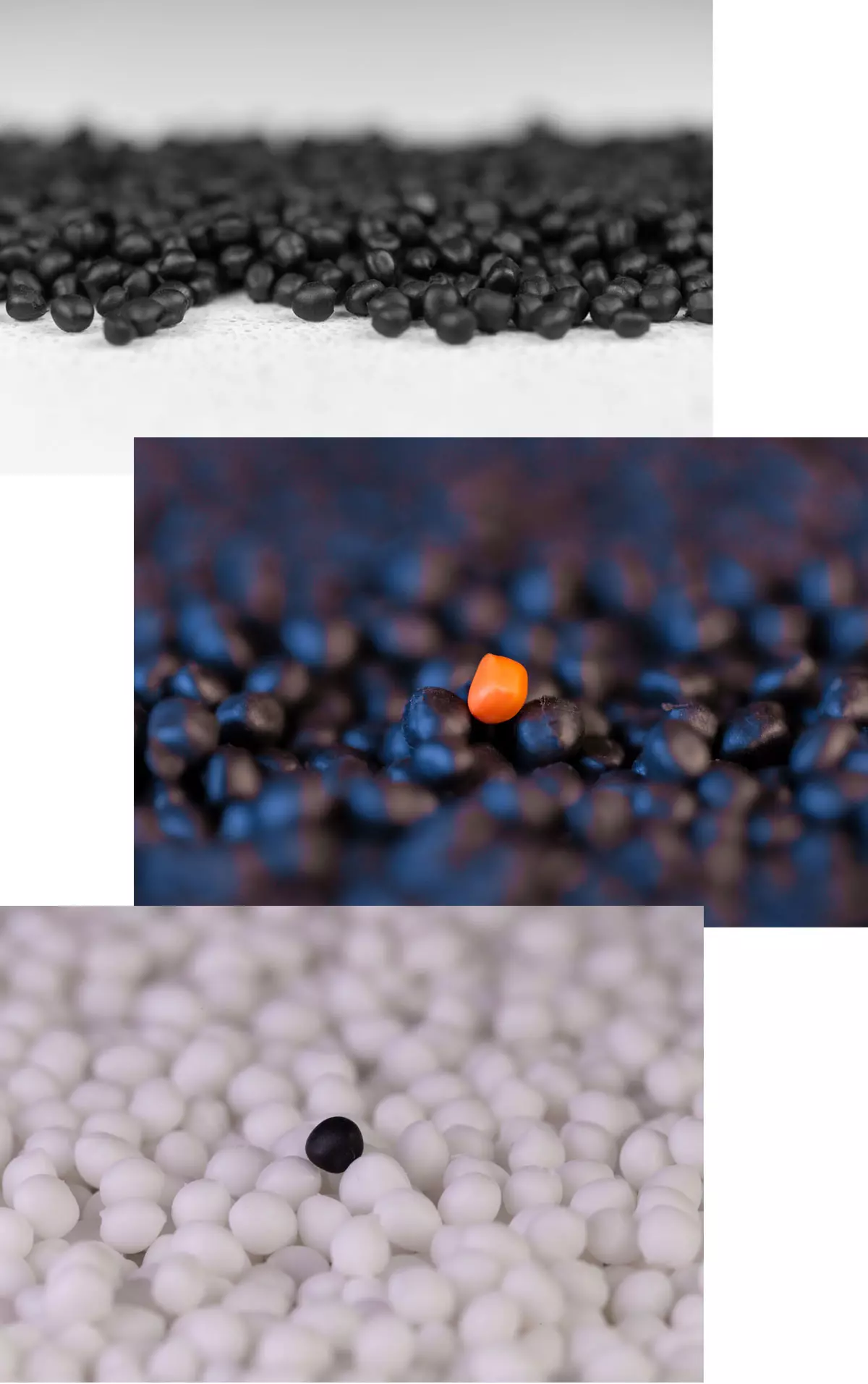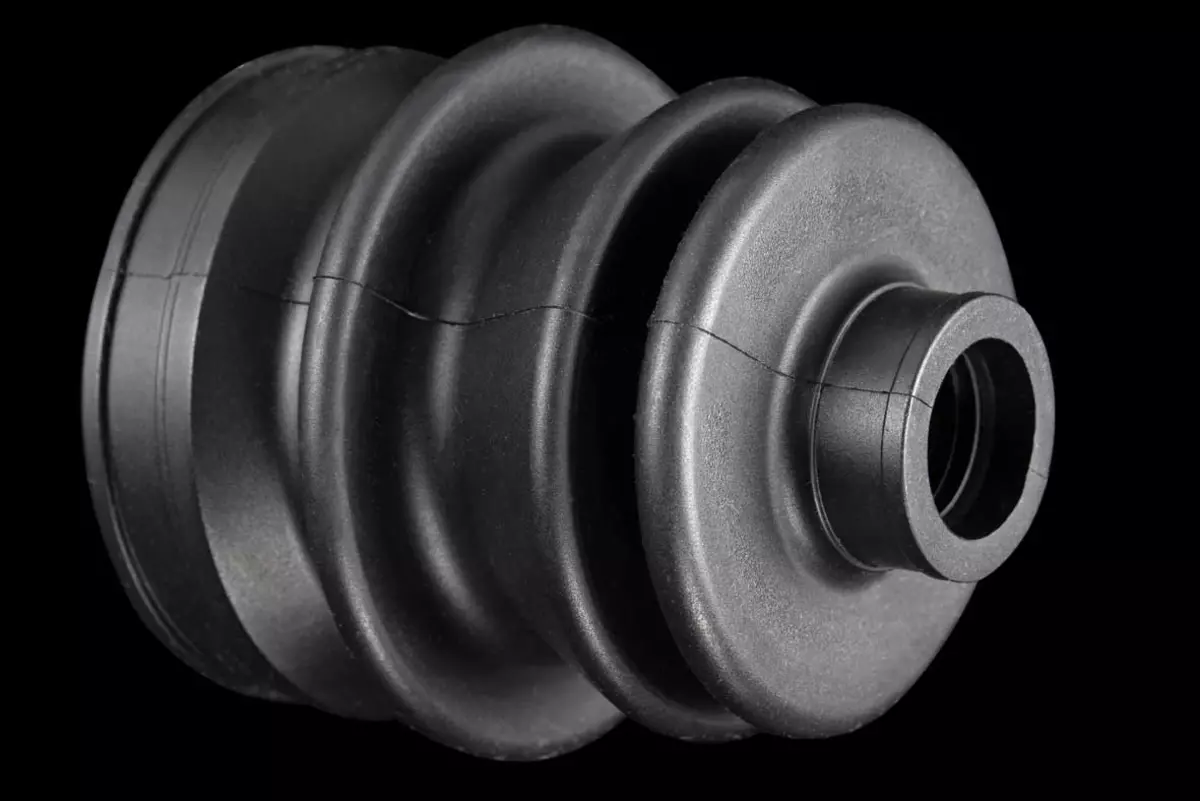
Thermoplastic Elastomers (TPE)
Thermoplastic Elastomers (TPE) combine the processing properties of thermoplastics and the physical properties if elastomers. The characteristics of TPE are very similar to those of rubber: They are soft, flexible and elastic.
At the same time, the thermoplastic phase causes the material to be processable on standard plastic processing equipment for injection molding, extrusion, blow molding, etc. Our products are completely recyclable.
Types of Thermoplastic Elastomers
Three categories of thermoplastic elastomers are differentiated according to their composition:
Styrene-block-copolymer-based TPEs are commonly referred to as TPE-S. TPE-S are typically based on SEBS, SBS, and SEPS. SBS compounds are used in applications with low requirements for UV-stability and thermal strength. SEBS compounds are weather-resistant and possess high temperature resistance.
TPVs, Thermoplastic Vulcanizates or Vulcanized Thermoplastic Elastomers, constitute a specialized group within TPE. They contain an elastomer phase (dynamically vulcanized EPDM), distributed in a polyolefin phase, thus granting these materials rubber-like properties. These compounds have excellent compression set, high elasticity, and are resistant to chemicals and oils. Their temperature resistance is also outstanding.
TPO, Thermoplastic Olefin blends, are a group of polyolefin (polypropylene)-based and EPR (Ethylene-Propylene-Rubber) modified compounds, which possess properties of rubber yet are processed like ordinary thermoplastics.
What are thermoplastic elastomers?
Thermoplastic elastomers (TPE) are a class of polymers that combine the mechanical properties of elastomers with the processing advantages of thermoplastics. They are able to soften when heated and solidify when cooled without losing their elasticity. This unique combination makes TPEs extremely versatile and recyclable.
Structure and types
The molecular structure of TPEs typically consists of a combination of hard and soft segments. The hard segments give the material structure and strength at higher temperatures, while the soft segments provide elasticity and flexibility at room temperature.
Main types of TPEs
- TPE-S (styrene block copolymers): Popular in applications that require flexibility and durability.
- TPV (Thermoplastic Vulcanizates): Known for their high resistance to environmental factors such as UV light and chemicals.
- TPO (Thermoplastic Polyolefins): Commonly used in the automotive industry and for outdoor applications where weather resistance is required.
Processing and applications
TPEs can be processed using conventional plastics processing methods such as injection moulding, extrusion and thermoforming. Their ease of processing enables a wide range of applications from the automotive industry and medical technology to packaging and toys.
Future trends and innovations
Research and development in TPE technology is focussed on improving performance properties such as temperature resistance and mechanical strength. Innovations that make TPEs more environmentally friendly and more efficient will further expand their areas of application.
Thermoplastic elastomers thus offer an efficient solution for modern material requirements by combining durability with environmental compatibility.
Environmental benefits and sustainability
A key advantage of TPEs is their recyclability. Unlike traditional elastomers, they can be melted and reformed, making them an environmentally friendly option. This recyclability supports the circular economy and reduces the need for virgin material.

Contact us!
We will be happy to answer your questions and advise you on suitable products.
Tel: +49 (0) 201 890 7760 E-mail: info@symplast.de
Fax: +90 232 325 73 73
TPE-S (styrene block copolymers): In-depth insights


Chemical structure and properties
TPE-S, or styrene block copolymers, consist of alternating blocks of styrene and an elastomeric material. This block structure enables a mixture of hard and soft segments, giving TPE-S both the processability of thermoplastics and the elastic properties of rubber. The hard styrene blocks give the material strength at higher temperatures, while the elastomer segments provide flexibility at room temperature.
Manufacturing process and environmental compatibility
TPE-S is manufactured using special polymerisation processes that allow precise control of the block lengths and ratios. This is crucial for the final material properties. TPE-S are fully recyclable, which increases their environmental compatibility and makes them a favoured choice in sustainable applications.
Advantages and technical features
The advantages of TPE-S include high flexibility and elasticity, good abrasion resistance and excellent colour acceptability. These properties make it ideal for applications that require both aesthetics and function. The technical characteristics also allow easy processing by injection moulding and extrusion, which reduces production costs and increases design freedom.
Challenges and development potential
The main challenge for TPE-S is their limited chemical resistance to oils and other hydrocarbons. Research and development is therefore focussed on improving these aspects by modifying the polymer structure or by combining it with other materials in order to extend the range of applications and increase performance in demanding environments.
TPE-S (styrene block copolymers) are therefore a key material in many innovative and technically demanding applications and are continuously being developed to meet the growing demands of the industry.
Go to Symflex® B Go to Symflex® S
Application examples and industries
TPE-S are used in a wide range of industries, including
- Automotive industry: For seals, hoses, rubber bearings and non-supporting internal parts.
Learn more - Consumer goods: In products such as toothbrush handles, soft-touch surfaces of household appliances and flexible containers.
Learn more - Medical technology: For hoses, seals and flexible housings that have to withstand frequent disinfection
Learn more
TPVs (thermoplastic vulcanisates): In-depth insights
Chemical structure and properties
TPVs or thermoplastic vulcanisates consist of a mixture of rubber that is vulcanised in a thermoplastic matrix during the manufacturing process. This structure allows TPVs to combine the elastic properties of rubber with the processing advantages of thermoplastics.
Manufacturing process and environmental compatibility
The use of dynamic vulcanisation during the manufacturing process gives TPVs a permanent cross-linking within the thermoplastic matrix. This process gives the materials a long service life and improves their recyclability compared to conventional elastomers.
Advantages and technical features
TPVs offer excellent chemical resistance, high temperature resistance and are very durable. Their flexibility and resilience make them ideal for applications that require both mechanical stress and environmental resistance.


Challenges and development potential
The greatest challenge for TPVs lies in their complex and cost-intensive production through dynamic vulcanisation. In addition, their application limits are defined by their limited resistance to extreme chemicals and temperatures. Research and development efforts are aimed at improving these properties, simplifying manufacturing processes and increasing efficiency to make TPVs accessible for wider applications and promote their market acceptance. They are crucial for many technical applications and are continuously being developed further.
Application examples and industries
TPVs are used in a variety of industries, including:
- Automotive industry: used for seals, hoses, dust caps and other flexible components.
Learn more - Construction industry: Use in elements that require weather resistance and durability.
Learn more - Consumer goods: Use in products that combine flexibility and durability, such as sports equipment or household items.
Learn more
TPOs (Thermoplastische Olefin-Mischungen): Vertiefte Einblicke


Chemical composition and processing
Thermoplastic olefin compounds (TPO) consist of polypropylene and unvulcanised rubber, usually EPDM. This mixture makes it possible to process the materials using common thermoplastic processes such as extrusion and injection moulding.
Manufacturing process and environmental compatibility
The production of TPOs (thermoplastic olefin blends) involves combining polypropylene with elastomeric materials such as EPDM in a blending process that supports both cost efficiency and high volume production. TPOs are particularly environmentally friendly as they are easily recyclable and have a lower environmental impact during production and at the end of the product life cycle. Their lightweight construction also contributes to energy efficiency in applications such as automotive manufacturing.
Advantages and technical features
TPOs are particularly known for their resistance to UV radiation and weathering. They are lightweight, flexible and offer good impact resistance, making them a favoured choice for outdoor applications.
Challenges and development potential
Development in TPO is focussed on improving compatibility with other materials to increase recyclability and processing efficiency. Work is also underway to improve performance under extreme environmental conditions.
These insights provide a detailed look at the properties and applications of TPVs and TPOs to meet the specific needs of the industry.
Application examples and industries
There are additional applications for TPOs (thermoplastic olefin compounds) in the areas you mentioned:
- Electrical: Insulation and protective covers for electrical and electronic components that require thermal and electrical insulation.
Learn more - Appliances & tools: Components for household appliances and tools that require high impact resistance and resistance to chemical substances.
Learn more - Medical & Care: Components for medical devices and packaging that require sterility and chemical resistance.
Learn more - Impact modification: Used in materials that require improved impact resistance for industrial and commercial applications.
Learn more
FAQ Thermoplastic elastomers
Thermoplastic elastomers are a class of polymers that combine properties of both plastic and rubber, making them elastic and mouldable when heated.
The most common types are TPE-S (styrene block copolymers), TPV (thermoplastic vulcanizates) and TPO (thermoplastic polyolefins).
TPEs can be processed using common plastics processing techniques such as injection moulding, extrusion and thermoforming.
They are used in the automotive industry, medical technology, packaging industry and in the manufacture of consumer goods.
Yes, TPEs are generally recyclable, which makes them an environmentally friendly option.
Unlike conventional rubber, TPEs are easily mouldable when heated and can be recycled multiple times without significant loss of performance.
TPEs offer a unique combination of flexibility, elasticity and environmental compatibility.
Yes, special TPE formulations are suitable for food contact and FDA compliant.
TPEs can have different degrees of hardness, elasticity and resistance to chemicals and temperature depending on their composition and processing.
The specific block copolymers and fillers in the TPE composition determine properties such as hardness, elasticity and resistance.

